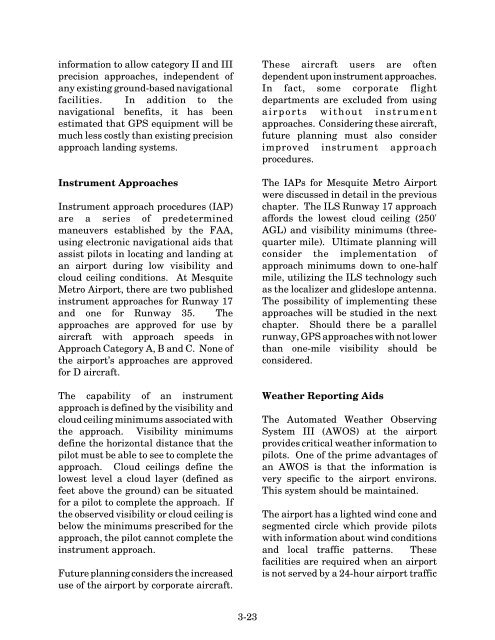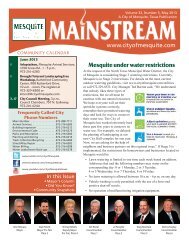airport/documents/Mesquite Master Plan Final.pdf - The City of ...
airport/documents/Mesquite Master Plan Final.pdf - The City of ...
airport/documents/Mesquite Master Plan Final.pdf - The City of ...
Create successful ePaper yourself
Turn your PDF publications into a flip-book with our unique Google optimized e-Paper software.
information to allow category II and III<br />
precision approaches, independent <strong>of</strong><br />
any existing ground-based navigational<br />
facilities. In addition to the<br />
navigational benefits, it has been<br />
estimated that GPS equipment will be<br />
much less costly than existing precision<br />
approach landing systems.<br />
Instrument Approaches<br />
Instrument approach procedures (IAP)<br />
are a series <strong>of</strong> predetermined<br />
maneuvers established by the FAA,<br />
using electronic navigational aids that<br />
assist pilots in locating and landing at<br />
an <strong>airport</strong> during low visibility and<br />
cloud ceiling conditions. At <strong>Mesquite</strong><br />
Metro Airport, there are two published<br />
instrument approaches for Runway 17<br />
and one for Runway 35. <strong>The</strong><br />
approaches are approved for use by<br />
aircraft with approach speeds in<br />
Approach Category A, B and C. None <strong>of</strong><br />
the <strong>airport</strong>’s approaches are approved<br />
for D aircraft.<br />
<strong>The</strong> capability <strong>of</strong> an instrument<br />
approach is defined by the visibility and<br />
cloud ceiling minimums associated with<br />
the approach. Visibility minimums<br />
define the horizontal distance that the<br />
pilot must be able to see to complete the<br />
approach. Cloud ceilings define the<br />
lowest level a cloud layer (defined as<br />
feet above the ground) can be situated<br />
for a pilot to complete the approach. If<br />
the observed visibility or cloud ceiling is<br />
below the minimums prescribed for the<br />
approach, the pilot cannot complete the<br />
instrument approach.<br />
Future planning considers the increased<br />
use <strong>of</strong> the <strong>airport</strong> by corporate aircraft.<br />
3-23<br />
<strong>The</strong>se aircraft users are <strong>of</strong>ten<br />
dependent upon instrument approaches.<br />
In fact, some corporate flight<br />
departments are excluded from using<br />
<strong>airport</strong>s without instrument<br />
approaches. Considering these aircraft,<br />
future planning must also consider<br />
improved instrument approach<br />
procedures.<br />
<strong>The</strong> IAPs for <strong>Mesquite</strong> Metro Airport<br />
were discussed in detail in the previous<br />
chapter. <strong>The</strong> ILS Runway 17 approach<br />
affords the lowest cloud ceiling (250'<br />
AGL) and visibility minimums (threequarter<br />
mile). Ultimate planning will<br />
consider the implementation <strong>of</strong><br />
approach minimums down to one-half<br />
mile, utilizing the ILS technology such<br />
as the localizer and glideslope antenna.<br />
<strong>The</strong> possibility <strong>of</strong> implementing these<br />
approaches will be studied in the next<br />
chapter. Should there be a parallel<br />
runway, GPS approaches with not lower<br />
than one-mile visibility should be<br />
considered.<br />
Weather Reporting Aids<br />
<strong>The</strong> Automated Weather Observing<br />
System III (AWOS) at the <strong>airport</strong><br />
provides critical weather information to<br />
pilots. One <strong>of</strong> the prime advantages <strong>of</strong><br />
an AWOS is that the information is<br />
very specific to the <strong>airport</strong> environs.<br />
This system should be maintained.<br />
<strong>The</strong> <strong>airport</strong> has a lighted wind cone and<br />
segmented circle which provide pilots<br />
with information about wind conditions<br />
and local traffic patterns. <strong>The</strong>se<br />
facilities are required when an <strong>airport</strong><br />
is not served by a 24-hour <strong>airport</strong> traffic




